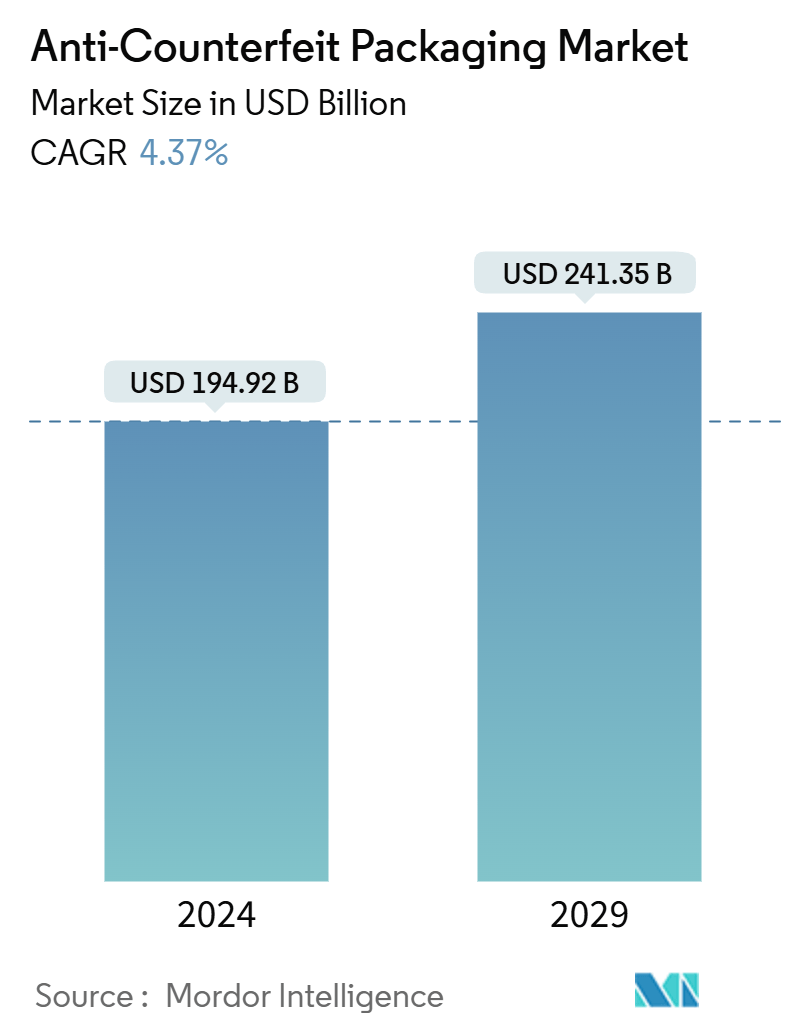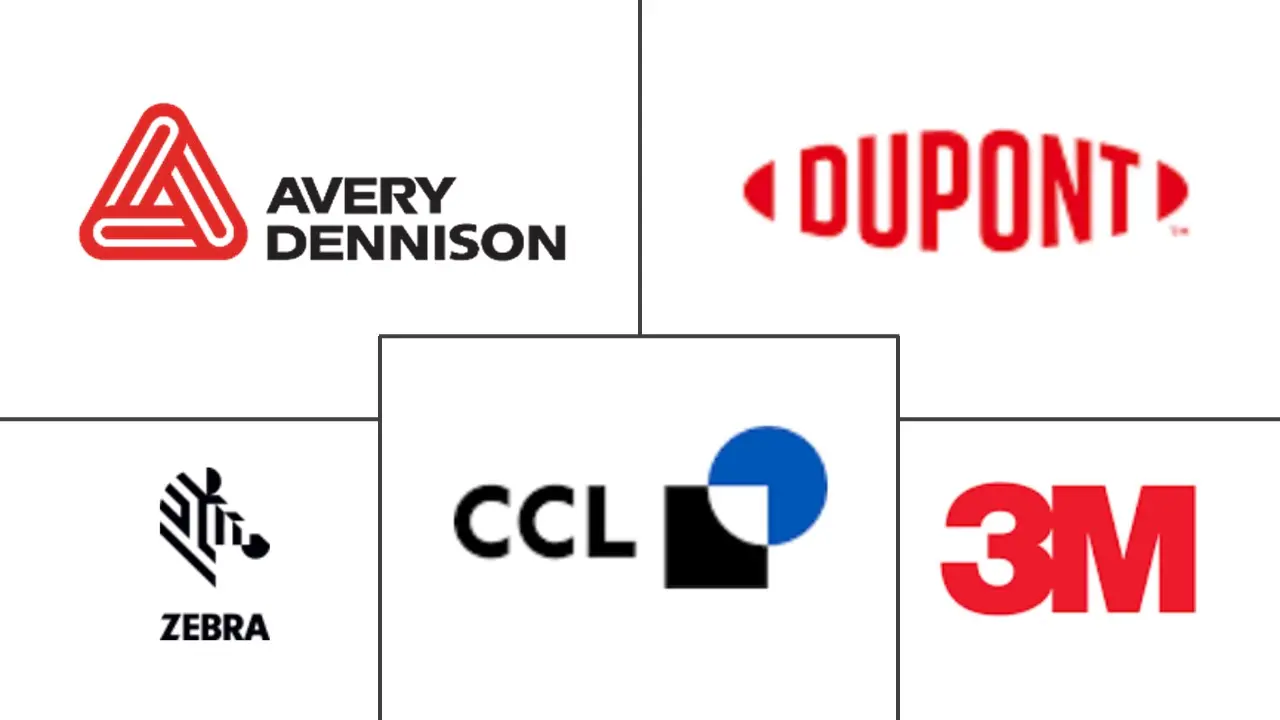Market Size of Anti-Counterfeit Packaging Industry

| Study Period | 2019 - 2029 |
| Market Size (2024) | USD 194.92 Billion |
| Market Size (2029) | USD 241.35 Billion |
| CAGR (2024 - 2029) | 4.37 % |
| Fastest Growing Market | Asia Pacific |
| Largest Market | North America |
| Market Concentration | Low |
Major Players
*Disclaimer: Major Players sorted in no particular order |
Anti-Counterfeit Packaging Market Analysis
The Anti-Counterfeit Packaging Market size is estimated at USD 194.92 billion in 2024, and is expected to reach USD 241.35 billion by 2029, at a CAGR of 4.37% during the forecast period (2024-2029).
The anti-counterfeit packaging market is witnessing growth, driven by evolving regulations to safeguard life-critical products, technological strides in anti-theft measures, a diverse array of emerging threats, and an increasing emphasis on brand protection.
- Regulatory measures, including the U.S.'s Anti-counterfeiting Trade Agreement and the EU Commission's labeling and serialization initiatives, are poised to bolster the market in developed economies during the forecast period.
- The surge of e-commerce has heightened the demand for anti-counterfeit packaging solutions. Online marketplaces have simplified counterfeiters' access to consumers. In response, brands are adopting advanced authentication features, like QR codes and near-field communication (NFC) tags, enabling customers to verify product authenticity via smartphones.
- Stringent regulations set by governments and regulatory bodies further fuel the market's expansion. Take the EU's Falsified Medicines Directive (FMD), which mandates unique identifiers and anti-tampering devices for all prescription medications. In China, regulations enforce track-and-trace systems for select product categories. Such mandates have catalyzed innovations in serialization technologies and secure packaging solutions.
- According to Macfarlane Group UK Ltd, in July 2024, customized anti-counterfeit packaging caters to the unique requirements of various industries. The pharmaceutical sector grapples with formidable challenges in safeguarding its products from counterfeit threats. To counteract this, consider integrating anti-counterfeit packaging features such as holographic labels, serialized QR codes, and distinct barcodes. These enhancements deter tampering and bolster product authentication, ensuring the pharmaceuticals' integrity throughout the supply chain.
- However, the market faces challenges owing to the high costs associated with setting up and innovating anti-counterfeit packaging, which deters new entrants and potential clients. Without adequate customer awareness, this hesitance and the ease of replicating existing technologies like barcodes and QR codes hamper market expansion.
Anti-Counterfeit Packaging Industry Segmentation
Anti-counterfeiting packaging is incorporated to prevent imitation and confirm the goods' safety. Companies take these measurements to help them minimize losses due to counterfeiting in terms of revenue and loyalty. The counterfeiting industry is flourishing, and it is not only the consumer goods market that is affected. There has been an increase in counterfeit prescription drugs, car parts, and technologies (such as cell phone batteries), which are flooding the market in the future.
The Anti-Counterfeit Packaging Market is Segmented by Technology (Trace and Track, Tamper-Evident, Covert, Overt, and Forensic Markers), End User (Food and Beverages, Healthcare and Pharmaceuticals, Industrial and Automotive, Consumer Electronics), and Geography (North America (United States, Canada), Europe (United Kingdom, Germany, France, Italy, Rest of Europe), Asia-Pacific (China, Japan, India, Australia, Rest of Asia Pacific), Latin America (Brazil, Argentina, Rest of Latin America), The Middle-East and Africa (South Africa, United Arab Emirates, Rest of Middle-East & Africa). The Market Sizes and Forecasts are Provided in Terms of Value (USD) for all the Above Segments.
| By Technology | |
| Trace and Track | |
| Tamper-evident | |
| Covert | |
| Overt | |
| Forensic Markers |
| By End-User Industries | |
| Food and Beverage | |
| Healthcare and Pharmaceuticals | |
| Industrial and Automotive | |
| Consumer Electronics | |
| Other End User Industries |
| By Geography | |||||||
| |||||||
| |||||||
| |||||||
| Australia and New Zealand | |||||||
| |||||||
|
Anti-Counterfeit Packaging Market Size Summary
The anti-counterfeit packaging market is experiencing significant growth, driven by the need for brand protection and the evolving regulatory landscape aimed at safeguarding the authenticity of life-critical products. Technological advancements in anti-theft measures and the increasing diversity of threats have further fueled this market's expansion. Regulatory measures such as the Anti-counterfeiting Trade Agreement in the United States and labeling and serialization initiatives by the EU Commission are expected to positively impact developed economies. However, the market faces challenges, including high setup and innovation costs, which deter new entrants and slow growth. Existing technologies like barcodes and QR codes are also easily replicable, limiting their effectiveness. The COVID-19 pandemic disrupted supply chains, causing raw material shortages and a temporary decline in demand for FMCG products, but companies have since focused on communicating the benefits of anti-counterfeit packaging.
North America stands out as a significant market for anti-counterfeit packaging, driven by increasing consumer demand for various products and a strong emphasis on brand protection. The region's mature market and refined regulations have bolstered its market share, despite challenges like high setup costs and less investment in R&D. The market is moderately competitive, with a few major players dominating, but many companies are expanding their presence through innovative and sustainable packaging solutions. Recent acquisitions and product introductions, such as Authentix's acquisition of Strategic IP Information and OPTEL's IdentifAI, highlight the industry's focus on enhancing digital security and product authentication. These developments underscore the market's commitment to addressing counterfeit threats and meeting growing consumer demands for transparency and traceability.
Anti-Counterfeit Packaging Market Size - Table of Contents
-
1. MARKET INSIGHTS
-
1.1 Market Overview
-
1.2 Industry Attractiveness - Porter's Five Forces Analysis
-
1.2.1 Bargaining Power of Suppliers
-
1.2.2 Bargaining Power of Buyers
-
1.2.3 Threat of New Entrants
-
1.2.4 Threat of Substitute Products
-
1.2.5 Intensity of Competitive Rivalry
-
-
1.3 Industry Value Chain Analysis
-
-
2. MARKET SEGMENTATION
-
2.1 By Technology
-
2.1.1 Trace and Track
-
2.1.2 Tamper-evident
-
2.1.3 Covert
-
2.1.4 Overt
-
2.1.5 Forensic Markers
-
-
2.2 By End-User Industries
-
2.2.1 Food and Beverage
-
2.2.2 Healthcare and Pharmaceuticals
-
2.2.3 Industrial and Automotive
-
2.2.4 Consumer Electronics
-
2.2.5 Other End User Industries
-
-
2.3 By Geography
-
2.3.1 North America
-
2.3.1.1 United States
-
2.3.1.2 Canada
-
-
2.3.2 Europe
-
2.3.2.1 United Kingdom
-
2.3.2.2 Germany
-
2.3.2.3 France
-
2.3.2.4 Italy
-
2.3.2.5 Spain
-
-
2.3.3 Asia
-
2.3.3.1 China
-
2.3.3.2 India
-
2.3.3.3 Japan
-
-
2.3.4 Australia and New Zealand
-
2.3.5 Latin America
-
2.3.5.1 Brazil
-
2.3.5.2 Argentina
-
-
2.3.6 Middle East & Africa
-
2.3.6.1 South Africa
-
2.3.6.2 United Arab Emirates
-
-
-
Anti-Counterfeit Packaging Market Size FAQs
How big is the Anti-Counterfeit Packaging Market?
The Anti-Counterfeit Packaging Market size is expected to reach USD 194.92 billion in 2024 and grow at a CAGR of 4.37% to reach USD 241.35 billion by 2029.
What is the current Anti-Counterfeit Packaging Market size?
In 2024, the Anti-Counterfeit Packaging Market size is expected to reach USD 194.92 billion.

